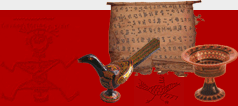|
再论彝族洪水神话
Reconsideration on the Flood Myth among the Yi Ethnic Minority
Nishiwaki Takao西胁隆夫
日本名古屋学院大学
【摘要】至今很多学者研究洪水神话, 其中不少日本学者如伊藤清司、君岛久子、斋藤达次郎、樱井龙彦等发表一些论文谈到彝族洪水神话。关于云南彝族的洪水神话,1997年我也作过报告,
但是没有弄清一些问题,如1)按方言地域把洪水神话分类;2)散文体和韵文体的差异;3)文本和口头传承的差异;4)洪水神话有三种类型,如兄妹婚始祖型(A型)、天女始祖型(B型)和A+B型。为什么这三种类型都在云南彝族流传;
5)变体或翻译的差异;6)神话中的要素,如洪水起因、人物的数目、避水工具、竹子和植物的意义、婚姻占卜、诞生和天神的存在等;7)毕摩和流传的问题。以后的得到了材料,如二十几篇神话、发现出下面的问题。第一、古代日本有一本史书叫做《日本书纪》。第一卷〈神代卷〉中有正文和一些异文。《勒俄特依》和其它彝族洪水神话之间也有相同的关系。第二、君岛教授曾经指出天女始祖型洪水神话是彝族传下来的、兄妹婚始祖型洪水神话是苗瑶和壮傣民族传下来的。那么,为什么云南彝族中有三种洪水神话?
我想,因为历史上彝族和其它民族有各种交流,接受其它民族的洪水神话的影响。毕摩在这个方面起过很大的作用。为了弄清楚洪水神话的面貌,彝族的洪水神话是很重要的。我们需要把彝族的神话跟其它民族的神话进行比较。
关键词:洪水神话 兄妹婚 天女婚
Abstract
Many scholars have studied flood myths. In Japan, Professors
Ito Seiji, Kimijima Hisako, Saito Tatsujiro, and Sakurai
Tatsuhiko published a paper on the flood myth of the Yi
Ethnic Minority. I also reported on the flood myth in 1997.
But my report lacked the following points: 1) arguing about
the flood myths of the Yi Ethnic Minority, it is important
for us to classify by dialect area; 2) the difference between
verse and prose; 3) the difference between the written and
the oral transmission in the form; 4) three types in the
flood myth: the elder brother marries the younger sister
in the type A; a younger brother marries a heavenly maiden
in type B; type A combines with type B in some myths; 5)
the differences that occurs in variation or translation;
6) the elements in the myth, such as the cause of the flood,
the number of brothers, the kind of the vehicle which avoids
a flood, the meaning of the bamboo and other plants, fortune-telling
for the marriage, the number of the children, the existence
of the heavenly gods etc; and 7) the difference of the narrative
art among bimo and other transmitters of the myth. After
writing that paper, I obtained some materials, including
seven myths in Yunnan, ten myths in Sichuan, and six myths
in Guizhou. By examining these materials, I became aware
of the following points: Firstly, in ancient Japan there
was a history book "Nihon shoki". Its first volume
is composed of a main text and several other auxiliary texts.
I thought there is a similar relation between Hnewo Teyy
and other myths in Yunnan, Sichuan and Guizhou. Secondly,
professor Kimijima pointed out that type B belongs to Yi
people, and Type A belongs to ethnic groups of the Miao-Yao
language family, or Zhuang-Tai language family. Why do Yi
people in Yunnan have the flood myth of type A or type A+B?
It is considered to be the result of the interchange between
Yi and other ethnic groups. So far, the scholars in Japan
argued about the flood myth in southwestern China without
considering the differences among regions and among ethnic
groups or subgroups. To make the problems clear, Hnewo Teyy
and other myths transmitted among Yi people prove a very
important fact. Accordingly, an extensive comparative study
is necessary for promoting folkloristic scholarship.
Keywords: flood myth─brother-sister marriage─heavenly
made
作者简介:
西胁隆夫, 生于东京都。1978年~1995年任岛根大学教授,任文学部中国文学研究室主任;1995年至2005年任名古屋学院大学教授。从上世纪80年代起一直致力于中国民间文学、尤其是中国少数民族文学的介绍及研究,先后前来中国访问近10次,并一度留学中国北京。他在岛根大学工作期间,曾创办《中国少数民族文学》杂志刊行了“当代中国少数作家短篇小说”、“新疆少数民族文学”、“东北内蒙少数民族文学”专辑,并先后撰写了几十篇文章,出版了《中国少数民族文学》一书。后调动至名古屋大学,埋头于新疆地区少数民族史诗研究。主要著作有:《中国少数民族文学》(1-3卷,1983至1988年),《阿诗玛》(合译,1999年),《关于云南彝族的洪水神话》(2000年),《中国少数民族文学》
(2001年),《再论日本的〈阿诗玛〉研究》(2005年)等。
About the Author:
Nishiwaki Takao, born in Tokyo. Professor, Shimane
University 1978~1995; Professor, Nagoya Gakuin University
1995~2005. His main works are: Ethnic Literature of China
(Vol.1, 2, 3, 1983~1988), Ashima (co-translated, 1999),
On the Flood Myth of Yi People in Yunnan (2000), Ethnic
Literature of China (2001), and Reconsideration on Ashima
Research in Japan (2005).
|





